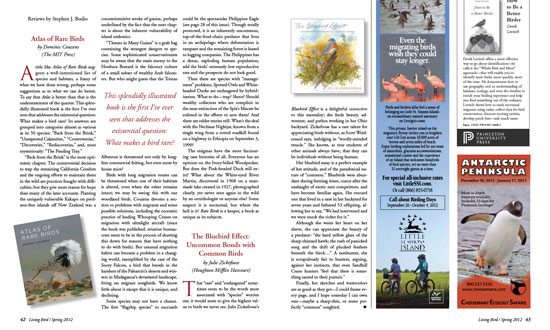Book Review: The Bluebird Effect, by Julie Zickefoose
Reviewed by Stephen J. Bodio
April 15, 2012
That “rare” and “endangered” sometimes seem to be the words most associated with “species” worries me; it would seem to give the highest value to birds we never see. Julie Zickefoose’s Bluebird Effect is a delightful corrective to this mentality; she finds beauty, adventure, and pathos working in her Ohio backyard. Zickefoose has a rare talent for appreciating birds without, as Scott Weidensaul says, indulging in “woolly-minded treacle.” She knows, as true students of other animals always have, that they can be individuals without being human.
Her bluebird essay is a perfect example of her attitude, and of the paradoxical nature of “common.” Bluebirds were abundant during farming times, scarce after the onslaught of exotic nest competitors, and have become familiar again. She rescued one that lived in a nest in her backyard for seven years and fathered 53 offspring, allowing her to say, “We had intervened and we were much the richer for it.”
Although she wears her heart on her sleeve, she can appreciate the beauty of a predator: “the hard yellow glare of the sharp-shinned hawk; the rush of panicked song and the drift of plucked feathers beneath the birch…” A nonhunter, she is scrupulously fair to hunters, arguing, against her instincts, that even Sandhill Crane hunters “feel that there is something sacred in their pursuit.”
Finally, her sketches and watercolors are as good as they get—I could frame every page, and I hope someday I can own one—maybe a sharp-shin, or some perfectly “common” songbird.

All About Birds
is a free resource
Available for everyone,
funded by donors like you
American Kestrel by Blair Dudeck / Macaulay Library


